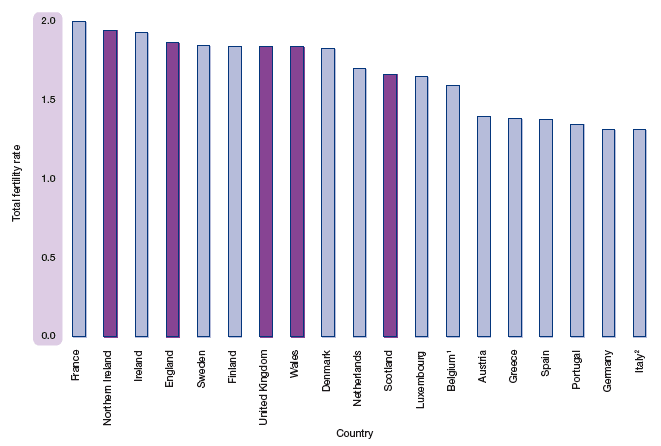
An invited chapter from Elspeth Graham (University of St Andrews), Lynn Jamieson (University of Edinburgh) and John MacInnes (University of Edinburgh).
Introduction
Scotland’s population has not been replacing itself. In recent decades, the number of children born to mothers living in Scotland has fallen below the number that would be needed to replace the present parent generation, given current mortality and migration rates. The annual reports of the Registrar General reveal the trend in birth rates, with fertility in Scotland declining significantly since 1964 when the total fertility rate (TFR) stood at 3.09 births per woman of reproductive age1. The decline of the 1970s is especially apparent in Figure 1.14 (see Chapter 1), which shows the trend in Scotland’s TFR since 1951. In the last few years, fertility rates in Scotland have moved upwards but, at 1.73 births per woman, the TFR remains below the generational replacement level of around 2.1 births per woman and Scotland currently has the lowest fertility of any of the constituent countries of the United Kingdom.
Although low fertility rates are not unique to Scotland and indeed Scottish fertility is above the EU-15 average (Figure 3.1), the position of Scotland with respect to other countries has shifted a little. Fertility rates were consistently higher than in England over many generations but, since around 1980, have been somewhat lower. Low fertility has consequences for the future size and age structure of the population and thus of the labour force. If fertility continues at the current level and there is little change in migration and mortality (the other factors influencing population size), the population will shrink. The latest Government projections suggest that the population
of Scotland will decline below 5 million around 2076. Scotland will also experience population ageing with an overall trend towards fewer young people and more people in older and very old age groups.
Figure 3.1 Total fertility rate, Scotland and EU-15, 2006

1 Data for 1997.
2 Data for 2005.
Source: EUROSTAT, General Register Office for Scotland,
Office for National Statistics and Northern Ireland Statistics and Research Agency.
Should we be worried? Does Scotland need a pro-natalist population policy to improve the age structure of its population or avoid eventual population decline? If so, whom should it target? Answering these questions is not straightforward. This chapter reviews evidence and arguments relevant to understanding the link between fertility, policy and the future of Scotland’s population. First we use recent evidence to examine differences between fertility rates in Scotland and England and geographical variations in fertility within Scotland. Then we present data on the behaviour and attitudes of both men and women in Scotland and consider the nature of men’s contribution, as well as women’s, to fertility trends. Finally we return to the more contentious issue of concerns raised by the likelihood of an older population and debates about policy agendas.
Identifying and explaining trends in fertility
Fertility is a challenging topic for research as good data are often difficult to obtain, and their interpretation is vigorously debated. The Economic and Social Research Council and the Scottish Government recently combined to sponsor a Scottish Demography Research Programme, which provided funding for a number of projects examining different aspects of Scotland’s population. In this chapter we draw on selected results from two of these projects2, as well as three other sources, to establish as complete a picture as possible of fertility in Scotland. The first project asked the question ‘Why is fertility in Scotland lower than in England?’ using data from the British Household Panel Survey (BHPS) covering the period 1991-20033. BHPS is a longitudinal survey that gives us the fertility histories (number of children and when they were born) and a great range of associated information for a sample of 5,460 women born in Scotland and England from 1955 onwards. The second project analysed the results of a set of questions about fertility included in the 2005 Scottish Social Attitudes Survey (SSAS)4. These questions were asked of a representative sample of those in reproductive age groups (men aged 18-49 and women aged 18-45) living in Scotland.
In this chapter we also present evidence from the annual General Household Survey (GHS) which asks women (but, unfortunately, not men) aged 16 to 59 about their fertility history and expectations. This gives us data for around 28,000 women in England and 3,000 women in Scotland interviewed between 1994 and 2005. Finally, we use data from the Census combined with birth registration data to look in detail at how fertility varies across different areas of Scotland. These diverse sources of evidence allow us to begin the task of identifying and explaining trends in fertility.
The historical context of fertility change
Despite new research, the causes of recent low fertility remain much debated. Part of the context is a long-term trend, across all affluent countries, away from very large families. At the start of the twentieth century, families of nine or ten children were common in Scotland and, on average, women had over five children (although around one in five had none: usually because they did not marry). A century later fewer than one in ten women in Scotland will have more than three children, and one in three will have a single child or none at all. These long-term changes are linked to increasing life expectancy and falls in mortality, especially infant deaths. Around one quarter of girls born at the start of the twentieth century died before their mid-twenties, while barely half reached 70 years of age; average life expectancy at birth was just 47 years. Mortality for boys was even higher. However, today much smaller numbers of people meet premature deaths through injury or disease and life expectancy at birth for girls is now around 80 years.
Across the twentieth century the social context of fertility also changed dramatically. Living standards rose continually while working hours declined. Women gained social and political rights and eventually formal discrimination by sex became unlawful. Divorce became not only legally but also socially and economically possible. Marriage ceased to be obligatory; ‘illegitimacy’ and single parenthood lost their stigma. Free comprehensive public healthcare became available and both infant and maternal mortality fell to very low levels. In the last decades of the century, the ‘male breadwinner’ division of gender roles weakened. Women’s employment grew and marriage and motherhood ceased to be associated with long-term withdrawal from paid work. The technology of contraception was revolutionised by the ‘pill’; abortion became legal and medically safer. Maternity and parental leave became available and the provision of public childcare, after school care and forms of state support to parenting expanded.
This broad historical context is common to all of the UK, and indeed most of Europe. However, from around the early 1980s relative fertility levels in Scotland and England changed. It is therefore useful to start our analysis of fertility in Scotland by looking more closely at why the fertility rate in Scotland is now below that of England, using data from the GHS and the BHPS.
Fertility in Scotland and England
Scotland had higher fertility than England until around 1980 when England’s TFR first exceeded that for Scotland. Since then England has continued to have a higher TFR (Figure 3.2). One explanation for the difference suggested by some commentators is that England has a larger immigrant population, whose fertility tends to be higher (Dunnell 2007). However, evidence from the BHPS shows that the fertility of women born in Scotland from 1955 onwards is lower than that of comparable English women even after those born outside the UK are excluded from the analysis. Evidence from the GHS confirms this finding when we exclude both women born outside the UK and women from ethnic minorities. A further possibility is that Scottish women have their first child at a later age than English women, leading to lower fertility overall. However, our analysis of BHPS data found that Scottish women tended to have a first birth at an earlier age. Half of the Scottish women in our sample cohorts had their first birth by age 27.4 years compared to 28.1 years for English women. GHS data showed no difference between women in Scotland and England in this respect, with an estimated median age at first birth of 27 years for both countries. Moreover, childlessness does not appear to be significantly more common among Scottish women compared to English women, with an estimated 17% of women in both countries remaining childless. Again GHS data confirm this finding, although the analysis estimates the level of childlessness for women aged 45 at 21% for both countries.
Figure 3.2 Total fertility rate in Scotland and England, 1971-2007
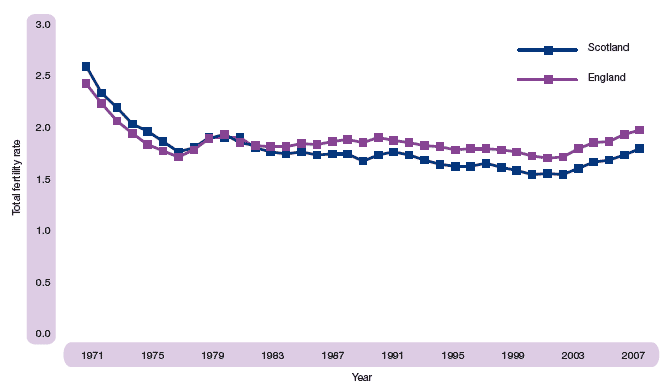
Comparing the details of women’s fertility behaviour in Scotland and England reveals differences which may begin to provide an explanation for Scotland’s lower fertility. BHPS data show that Scottish women leave longer gaps between births. Fifty per cent of English-born women have a second birth within 3.2 years of their first birth, compared to 3.5 years for Scottish-born women; and 25 per cent of English women have a third birth within 3.3 years of their second birth, compared to over 4 years for Scottish women. Scottish women are also more likely to ‘stop at one or two’ children. Again results from the GHS confirm this pattern. Estimated mean age at second birth, at 31.3 years, is about six months higher than for England. By age 45 about 22.4 per cent of women in Scotland had three or more children, compared to 26.7 per cent in England. Thus patterns of spacing births and stopping reproduction appear to be different in Scotland and England. However, we still lack a convincing explanation of why this is so.
We can also study people’s fertility intentions and expectations using the GHS and BHPS surveys. Such data have to be interpreted carefully, as we cannot assume that people always have a clear idea, especially at earlier ages, of how many children they wish to have. Longitudinal studies in other countries have found only rather weak relationships between people’s fertility preferences and their subsequent behaviour. This is what we might expect, since people may have little individual control over aspects of their lives that are important to fertility decisions, such as the course of their career or that of their partner, or over how an intimate relationship develops. However, at an aggregate level, what happens to the intentions or expectations about fertility that women of different ages have over time can tell us something about the factors influencing fertility.
The BHPS study suggests that there are no significant differences in the fertility intentions of Scottish and English women. One possible implication is that there are barriers operating in Scotland which result in Scottish women being less likely than English women to achieve their original intended family size. The GHS asks women under 50 about whether they ‘expect’ to have any more children, and if so, how many children they ultimately expect to have. Figure 3.3 plots the fertility expectations, by age group, of women in Scotland and England comparing results from the GHS surveys carried out since the year 2001, and surveys from 1994-98. For comparison, the Figure also records the actual fertility history of the women in each age group as recorded by the later series of GHS surveys. As we would expect, once women are in their forties, very few expect to have more children, so that expectations and behaviour converge. While in the surveys between 1994 and 1998 average expectations change little over the life course, staying close to two children in both countries, in the more recent surveys expectations shift downwards in older age groups, and to a lower level in Scotland than in England. This suggests that more women in Scotland than in England revise their fertility expectations downwards as they get older. We also know, from comparing the results of earlier GHS surveys, that fertility expectations in both countries have shifted downwards for all age groups over the last three decades (Smallwood and Jeffries 2003; MacInnes and Pérez 2007). It seems that this process has been more significant in Scotland than in England.
Figure 3.3 Expected fertility by age group: Scotland and England 1994-98 and 2001-05
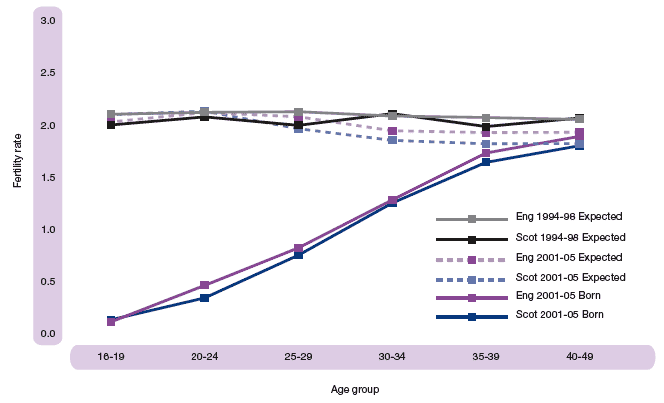
Geographical variations in fertility
A further approach to understanding Scotland’s fertility involves examining how fertility ideals and behaviour vary geographically within Scotland. The fertility module added to the SSAS 2005 reveals some interesting variations across different types of neighbourhood. Respondents were asked how many children they would ideally like to have, ‘thinking in general and regardless of your current circumstances’. Figure 3.4 shows the distribution of what both men and women say is their ideal family size according to the perceived quality of their neighbourhood for bringing up children. Overall, only a minority (under 20%) of men and women in Scotland think that no children or one child is the ideal family size. Nevertheless, of these, it is men living in neighbourhoods perceived as ‘bad’ or ‘very bad’ who are more likely to think that no children is ideal, and it is women living in similar neighbourhoods who are more likely to think that one child is ideal. For the total sample, those living in areas considered ‘very good’ for bringing up children are most likely to say that two children is their ideal, whereas men in ‘bad’ or ‘very bad’ neighbourhoods are most likely to consider three or more children the ideal. Despite the unreliability of people’s ideal family size as a predictor of fertility behaviour, these geographical variations strongly suggest a link between where someone lives and their ideas about fertility.
Figure 3.4 Ideal family size by gender and perceived quality of local area for bringing up children
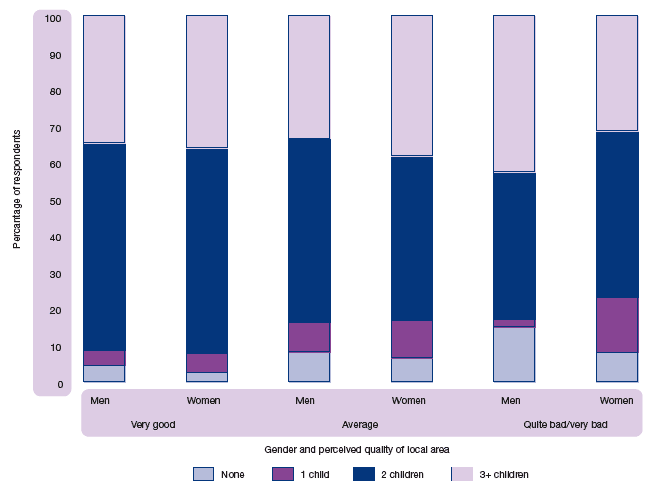
Source: Scottish Social Attitudes Survey 2005
When we examine fertility behaviour across Scotland using complete national data from the census and the registration of births rather than a sample survey, another interesting spatial pattern emerges. We know that fertility varies geographically according to the age structure and socio-economic characteristics of local populations. For example, neighbourhoods with a high proportion of the population aged over 50 years can be expected to have few births, as can areas with a large student population. However, even when we take these known variations into account, geographical differences are still evident. When we map the variations in the numbers of births in small areas of Scotland after a range of factors known to influence fertility is taken into account, we find clusters of lower than average and higher than average fertility that are unexplained by the age structure or socio-economic characteristics of local populations (Boyle et al. 2007)5. The clustering of lower fertility in the major cities and higher fertility in the surrounding commuter belts stands out, and is especially pronounced around Glasgow and Edinburgh.
The challenge of explaining the pattern remains but it may be the result of selective migration. For example, it is plausible to suppose that couples are moving out from central cities if and when they have children, prompted perhaps by the lack of affordable family housing in the city. Thus, the housing market in urban Scotland could be one of the barriers to higher fertility. It would seem that central cities, in particular, are not family-friendly. The geographical separation of families from the mainly childless has increased over time and creates problems for working parents who have to commute into the city. The costs and location of childcare, along with commuting distances, are major issues for working parents with young children. One response may be to have fewer children than the couple would otherwise want.
The role of men
Much of the research on fertility focuses on women’s expectations and behaviour. Many surveys only ask questions of women. However, men are more often partners in having and bringing up children than simply biological fathers. The module of questions about fertility included in the SSAS 2005 allows us to look at men’s attitudes towards fertility, although some of the results are based on rather small sample sizes. The overall sample size for the module was 781 individuals (406 men and 377 women) of childbearing age. When it is subdivided to compare men and women by age and whether or not they have children, totals in each category become quite small, although usually around a hundred. Thus the evidence should be read as an indication of people’s views rather than as definitive. We also draw upon evidence about men and women’s attitudes to the family in Scotland from SSAS 2000.
The annual reports of the Registrar General show that almost half of all births are now to unmarried parents but that the overwhelming majority of new-borns have a mother and a father living at the same address. Moreover, a long-term stable partnership between two parents is still very widely regarded as the appropriate arrangement for bringing up children, even if it is less often achieved. The SSAS 2000 showed a weakening but not a collapse of the presumption that the best parenting arrangement is a legally married man and woman. When adults of child-rearing age were asked whether they agree or disagree that ‘People who want children ought to get married’, many opted for ‘neither agree nor disagree’ or ‘I cannot choose’. Nevertheless, among nearly 200 childless adults aged 18-29 years, 41 per cent of young women and 33 per cent of young men agreed. And for the majority of people, having a partner, albeit not necessarily a marriage, remains a prerequisite to having children.
Widespread economic and ideological changes have undermined the combination of ‘male breadwinner’ and ‘housewife’ as the dominant model of family household across much of the wealthy world. It has been replaced by dual-earner households and a radical increase in the number of women combining paid employment with bringing up children. The fertility module of the SSAS 2005 demonstrates that very few men and women of childbearing age (fewer than one in five) support the idea that men should be the main breadwinner when both parties of a heterosexual couple are employed. The results also suggest that women anticipate motherhood or an additional child as having a greater impact on their employment than men anticipate from fatherhood (Figure 3.5). Men and women appear to differ both in their anticipation of the impact of having a child on work progress and in their actual experience of the impacts of parenthood. In most dual-earner households with children, women continue to do more of the domestic and child care work than men. Although an overwhelming majority in the sample agreed that men and women in couples should play an equal part in domestic work, most men and women in such households also agreed that, in practice, women actually did more.
Figure 3.5 Percentage of people who agreed that ‘work progress would suffer if I had a(nother) child’**
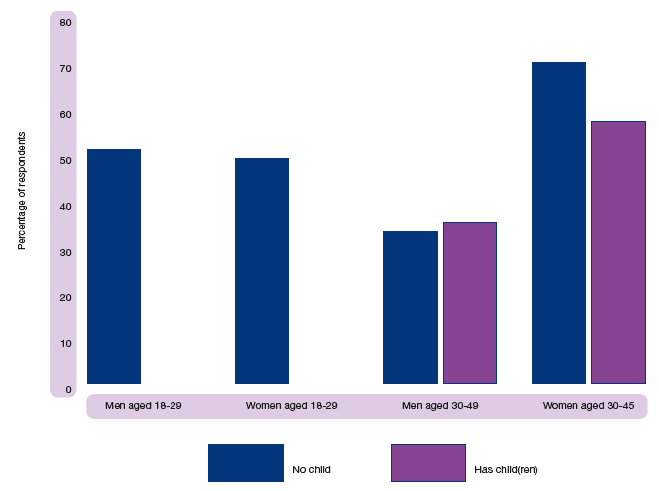
** Those in the younger age group with children have been excluded because of the small numbers.
Over half the men and women in the sample agreed that ‘it is difficult for both parents to work if they have more than two children’ (Figure 3.6). Here we include the 66 parents in the younger age group, whether or not they were in employment. Women with children and women over 30 may have more reason than men to anticipate the practical impact of children on their own time and on their employment prospects but men, especially young men, were even more likely than women to agree that having more than two children makes it difficult for both parents to work. This suggests that men may remain more attuned than women to the risk that children or additional children will result in men becoming the sole household earner. Thus, although traditional gender roles are no longer seen as being the right thing to do, it seems that they continue to give men and women different reasons for avoiding larger families. This is the case even when, for some, the ideal family size is three or more children.
Figure 3.6 Percentage of people who agreed that ‘it is difficult for both parents to work if they have more than two children’
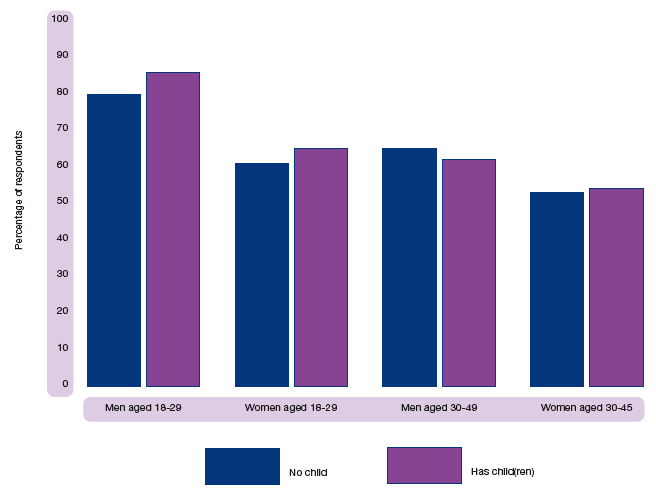
Overall, no significant gender differences in ideal family size were found, with the majority of both men and women regarding two or more children as ideal. However, there are some differences between the childless and those who already have children, and between those over and under age 30 (Figures 3.7a and 3.7b). Among the childless the younger age group of both men and women were more likely to favour two children than were those in the older age group, while among those who have at least one child a notably higher percentage in both age groups reported three or more children as their ideal family size. Again caution is required here because of the small numbers of younger parents, but the pattern of revising family size ideals with age is suggested at least for those already committed to parenthood. Those who were still childless at aged 30 or over were more than twice as likely as the younger childless to say that their ideal was to have no children, although the majority still had an ideal of at least two.
Figure 3.7a People with no children: ideal family size
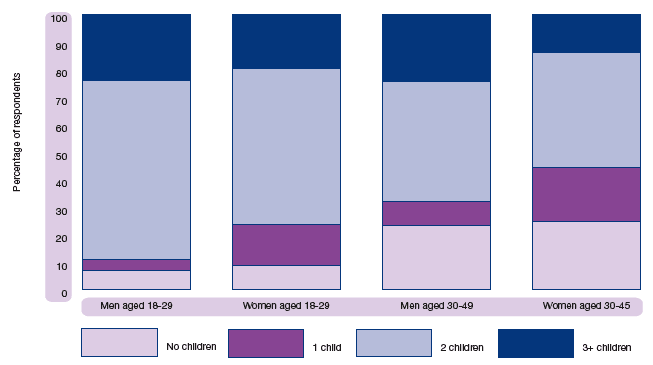
Figure 3.7b People with at least one child: ideal family size
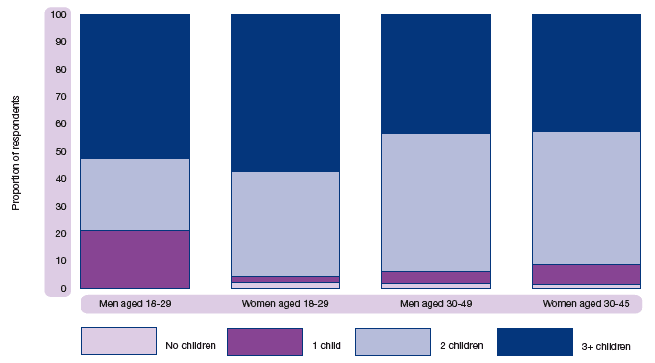
Although men and women apparently share the same fertility ideals, the discussion of combining parenthood and employment has illustrated how this can nevertheless translate into different attitudes to possible advantages or disadvantages of a particular family size. This is again illustrated by attitudes to having an only child. While the majority of both men and women agreed that ‘an only child can be just as happy as a child with siblings’, rates of agreement were about 10% higher among men compared with women. The evidence reviewed from the SSAS 2005 suggests that men and women have slightly different concerns about the impact of a(nother) child. This may mean that, when acting as a couple, they have an additive effect, exacerbating the tendencies in each other to delay having children. The evidence, although not conclusive, supports the view that men and women are mutually reinforcing low fertility.
Our knowledge of the causes of low fertility is growing but uncertainties remain. It is not clear, for example, how the housing market and the labour market in Scotland influence men’s and women’s decisions to partner and to have, or not to have, children. The scope for debate is further increased when we consider the implications of demographic change in Scotland and whether or not a fertility policy should be contemplated.
The implications of demographic change
The latest population projections show how the age structure of the Scottish population is predicted to change over the next twenty-five years (see Figure 1.7, Chapter 1). They indicate a 7 per cent decline in both the 0-15 years and 16-29 years age groups between 2006 and 2031. The projected 10 per cent decline in the working age groups reflects earlier low fertility. In contrast, the retirement age groups are both projected to increase significantly, with those aged 75 and over rising by 81 per cent over the next quarter century. As we noted in the introduction, these projections also suggest that the overall size of Scotland’s population will decline to below five million by around 2076.
Such changes in the size and age structure of the population have led many observers to suggest that population ageing and the speed with which it is happening in Scotland relative to the rest of the UK pose social and economic challenges that require policy makers to address the issue of fertility directly (Graham and Boyle 2004; Wilson and Rees 2003). However, others (MacInnes and Pérez 2007) have argued that low fertility and changes in the age structure of the population are better seen as part of a longer term shift in the demography of modern societies, and that any policies should be concentrated on the effects of this shift. Here we review some of the main aspects of this debate.
Dependency ratios
Dependency ratios compare the number of people of working age in the population to those below and above this age. In 2006, there were 59 dependents for every 100 people of working age in Scotland. Low fertility in the recent past means that this ratio will worsen as the baby-boomers of the 1950s and 1960s retire. Worries focus on the future care of older citizens, costs to the NHS and the relative decline in the size of the workforce in the face of increasing demands for young talent. The UK Government has already recognised the implications for the pensions system and has responded to this and other issues, such as gender equality, by redefining ‘working age’. By 2046, state pension age will increase by stages from the current 60 years for women and 65 years for men to 68 years for both. Even taking these changes into account, by 2031, the dependency ratio is likely to be 67 dependents for every 100 people of working age, with a higher proportion of older people amongst them. Thus increasing the working life-span by at least three years will mitigate but not reverse the worsening dependency ratio.
Critics of dependency ratios argue that age itself is a poor guide to ‘dependency’ (MacInnes and Pérez 2007). The employment rate of working age women has almost doubled over the last forty years, few youngsters enter the labour market at 16 and only around one half of those in employment currently work until statutory retirement age or beyond, although men are more likely to retire early than women. Thus increasing this age may simply increase inequality by forcing the minority who cannot afford to retire early to work longer (MacInnes 2006). Although older people may not be economically active, they do large amounts of important unpaid work: in the UK, grandparents are the single most important source of childcare after parents themselves. Older people also transfer large amounts of money as well as time to the next generation. While the large rise in the proportion of the population who are very old will certainly increase the costs of the NHS and social services, such change is an inevitable consequence of improved life expectancy. As long as life expectancy continues to increase (in the decade to 2005 it rose by 2.5 years for men and 1.9 years for women in Scotland) increasing fertility cannot halt the shift in the age structure of the population.
A deficit of young talent in the labour market
The ageing population is likely to increase demand for certain services such as health care. This will result in a need to increase the numbers of trained doctors and nurses. Scotland will also need innovators and skilled IT workers to ensure a vibrant economy. The worry is that there will be a recruitment deficit in these key areas since continuing low fertility will reduce the numbers of younger people entering the workforce. Although there is much debate about the extent to which older workers can fill such gaps, some economists argue strongly that in many cases older-aged workers cannot provide a substitute for young talent (Wright 2002).
Critics of this pessimistic view argue that economies have always faced challenges posed by shifts in the age structure of the workforce and it may be misleading to draw conclusions about the advantages and disadvantages of different workforce age structures from how firms have behaved in the past. Labour shortages are often an important pressure towards innovation in human resource management, and developing new ways of managing human resources may be a less costly and more certain option than devoting resources to policies designed to increase fertility which, even if they were successful, would operate only in the long term.
Population decline and political influence
An additional, though less frequently expressed, worry concerns the implications of a decline in the total population of Scotland relative to the population of the rest of the UK. If Scotland’s population share declines, then its political influence may also decline, especially if there is a reduction in the number of Scottish MPs at Westminster.
In the first half of the twentieth century, as governments realised that fertility was falling, many states pursued pro-natalist policies because they feared the military and political consequences of population decline (Teitelbaum and Winter 1985). However, apart from the ethical issues raised by such policies (especially when there is no global shortage of population), fertility behaviour has now become so firmly established as an individual and private matter that patriotic calls for larger families to boost a nation’s influence are not likely to work. There may even be benefits associated with a declining population size. A smaller population might mean a reduction in environmental impact with less pressure on infrastructure, such as housing and roads. However, economic performance will be an important determinant of the capacity to invest in a greener future. If population decline reduces economic performance, for example, this could restrict the development of better public transport or alternative energy sources.
The case for a population policy
Worries such as these have already led to calls for a population policy for Scotland which would secure its economic and political future. When the Scottish Government outlined its economic strategy in November 2007, it set a target for the growth of "… our greatest asset, Scotland’s people". The target is to ensure that population growth in Scotland matches average European (EU-15) growth over the period 2007 to 2017. There are a great many uncertainties about such a target, not least predicting the likely trend in fertility across fifteen European countries some of which, like France, currently have higher fertility than Scotland, whereas others, like Italy, currently have lower fertility (shown in Figure 3.1). Nevertheless, the implication is that meeting this target will require some growth in Scotland’s population for it is clear that the Scottish Government sees population increase as a key contributor to a more vibrant society and a more dynamic economy.
To achieve population growth and ensure at least the current total population size in the longer term would require either a sustained increase in fertility or a year-on-year increase in net in-migration to Scotland, or both. The Scottish Government expects migration to continue to play a major role. The best strategy, however, might be a combination of more births and more migrants, although there are many limitations on the extent to which the Government can, or should, pursue such a goal. The Fresh Talent initiative, for example, has played only a small part in retaining young graduates for the Scottish employment market and, whilst migrants from Eastern Europe continue to fill gaps in local labour markets, their presence may prove temporary and thus not a long-term fix for Scotland’s current demographic deficit. Introducing measures to encourage an increase in fertility may be even more problematic, although fertility increase is likely to be more effective as a way of reversing population ageing.
A fertility policy for Scotland?
The key question is: ‘Can and should the Government intervene to reduce barriers to higher fertility?’ Scotland’s fertility level currently lies in what has been called the "safety zone" above 1.5 births per woman6. Nevertheless, Scotland experienced fertility below this level in the early years of the new millennium and it may be prudent to consider policies that would sustain or increase its present level (McDonald 2006). However, pro-natalist initiatives in other countries appear to have had limited or no success, although this is a matter of some debate. France and Sweden, for example, have family policies that encourage fertility but their TFRs remain below generational replacement level. While the incentives in France – with a TFR of 1.98 in 2006 – have arguably maintained fertility at a higher level than in many other European countries, the effect of incentives in Sweden is a matter of greater debate. TFR in Sweden fell below that in Scotland in the late 1990s but has been on an upward trajectory since the turn of the millennium and reached 1.85 births per woman in 2006 compared to 1.67 in Scotland. Further, Singapore introduced strong pro-natalist incentives two decades ago but their impact on national fertility was short-lived. Singapore now has one of the lowest fertility rates in the world with a TFR of just 1.26 in 2006.
There is widespread agreement that direct Government intervention in the fertility decisions of couples in Scotland is as undesirable as it is likely to be ineffective. However, there is vigorous debate about whether or not a more indirect approach to influencing future fertility ought to be contemplated. We end the chapter by presenting two different, but not mutually exclusive, conclusions, which reflect the scope of the debate.
Conclusion 1: a family-friendly Scotland
A modest increase in fertility would slow population ageing in Scotland and be good for the economy and Scotland’s position in the UK in the longer term. However, the lesson to be learned from other countries where pro-natalist policies have been introduced is that any policy measure aimed at increasing fertility could involve considerable costs for little return. Where an economy depends on dual-earning couples, it is difficult for the Government to intervene successfully in order to increase fertility. There are policies, however, that have benefits other than fertility increase but which might provide indirect incentives to Scottish couples to have a(nother) child. The recent extension of paid maternity leave in the UK, for example, may further encourage the upturn of fertility evident in the past few years. More generally, making it easier for couples to work and raise families at the same time is a worthwhile policy aim, which could help to maintain or even increase fertility.
Indirect incentives to increase fertility will only have a positive impact if they remove perceived barriers to having (more) children, with the aim of ensuring that Scottish couples fulfil their fertility goals. All the evidence suggests that most couples in Scotland want at least two children, yet revise their fertility goals downwards as they grow older. There are likely to be multiple reasons for this revision, including responses to the expense and practical difficulties associated with having children. Nevertheless, and despite recent legislation designed to make workplaces more family friendly, there remain significant barriers to combining employment and family, especially for women. The geographical separation of home, workplace and childcare is one of these. As a first step, therefore, the Scottish Government could consider broader measures that would create a family-friendly environment throughout Scotland, but especially in the cities. Keeping families in the cities would reduce commuting times and make it easier for parents to combine work and family life. This would have the advantage of creating more balanced local communities but it might also encourage couples to have the number of children they want.
Finally, TFR in Scotland, though below the level recorded for England, continued to edge upwards in 2007. It is too early to say whether this trend will be sustained or what the influence of recently introduced family-friendly policies might have been. The rise in annual fertility could be the result of shifts in the timing of births rather than an indication that future completed family size will be larger than it has been in the recent past. On the other hand, if the upward trend does continue and indeed is encouraged by new family-friendly policy initiatives, then many of the worries associated with population ageing and decline could be resolved.
Conclusion 2: managing the effects of population change
What often appear as barriers to higher fertility can also be seen as the result of the new freedom in modern societies of potential parents, especially mothers, to choose how many children they want. Over the last fifty years, most barriers to alternatives to motherhood for women have been dismantled. Discrimination by sex in employment and education is unlawful. Family, divorce and abortion law have been reformed. Social norms no longer reduce femininity to domesticity and motherhood, and beliefs about what is appropriate for men and women will continue to change. Parents have rising aspirations for their children, investing increasing time and resources in them. However, although dual-earner families are now the norm and people believe in the ideal of gender equality, women continue to carry a greater burden of parenting obligations and of reconciling them with employment.
This new social context explains why pro-natalist policies are often expensive failures. Rather than trying to increase fertility directly, the emphasis should be placed on policies that are children-friendly in the widest sense, so that some of the burdens and responsibilities of parenthood are shared, and which bring social benefits regardless of whether fertility rises (Folbre 1997). Policy ought to promote gender equality in parenting. Many countries with very low fertility are those where women’s equality has progressed the least. Although alternatives to motherhood have opened up for women, men have not moved as quickly to assume an equal share of parenting work. Work-life balance policies aimed at fathers could encourage this.
Finally, policies ought to concentrate on managing the impact of changes in the age structure of the population, including the population of working age. Firms should be supported to innovate in human resource management. Increases in the costs of care for the very old are inevitable. The difficult question is how inter-generational transfers of resources should be managed. To the extent that elder care is provided by the state, taxes will have to rise, which raises economic and political questions. On the other hand, if the inter-generational transmission of wealth occurs mostly within families, this will become an increasingly important factor in social inequality. Population ageing is in part the result of welcome increases in life expectancy that even large, and unsustainable, increases in fertility cannot avert. Fertility itself should not be a policy objective, especially if the underlying objective is to pursue population growth for its own sake. Managing population change certainly should be.